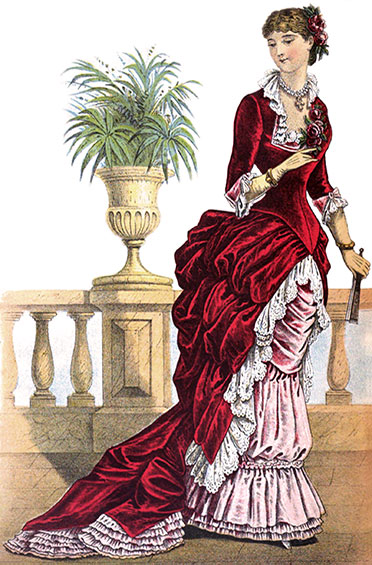Victorian Bustle: Hidden Secret Behind the 1880s Silhouette
 |
|||||||||||||
By the 1880s, the soft curve bustle dresses of the early 1870s were replaced with a new distinct silhouette featuring a severely tailored figure from the front and added draperies to the back. The train had disappeared and a bustle or tournure with a fitted gored skirt produced a profile straight in the front, hugging the hips, and exploding into a back fullness that was gathered or pleated. |
|||||||||||||
|
|
|||||||||||||
 |
|||||||||||||
| Bustle silhouette highlighted in Victorian dresses from 1888. | |||||||||||||
Many of the Victorian costumes of the 1880s featured long draped overdresses, which reached to the top of a narrow flounce, side by side with a very short tunic, which was not more than a large scarf. The skirt would fall straight and flat in front and a small tournure or bustle was worn to support the back drapery, giving the skirt below the waist a bouffant appearance. |
|||||||||||||
 |
|||||||||||||
| Two Victorian costumes featuring the bustle skirts of 1888. | |||||||||||||
Basques, pointed waists, coat bodices, and round waists with belts were all worn with the new bustle skirts; the selection of the particular style of top was made to suit the figure of the wearer. Sleeves were placed high up on the shoulders making the shoulder seams quite short, giving a narrower appearance to the broad-chested woman but a rather unbecoming look to the very thin woman. The 1880s dresses were styled quite high about the neck at the back to accommodate the hair, which was worn generally high. |
|||||||||||||
 |
|||||||||||||
| Photograph of Victorian women in various versions of the 1880s style. [Library of Congress] |
|||||||||||||
An absolute necessity for this Victorian style of dress was a well-fitting tournure or bustle and it soon became an indispensable accessory to a lady's costume. The bustle was a device to expand the skirt of the dress below the waist. |
|||||||||||||
 |
|||||||||||||
| Victorian Butles from the 1880s. [Photo Credit: Metropolitan Museum of Art Gallery Collection, www.metmuseum.org] |
|||||||||||||
These padded devices were used to add back fullness to the hard-edged front lines of the 1880s silhouette. The various styles of bustles were made with wires, springs, mohair padding and fabric, appearing both archaic and torturous. Although lace appeared out-of-place on the bustle, it was often incorporated into the design. But, although the tournure was suitable for a walking dress, it was not always sufficient to maintain the voluminous trained skirt of an evening dress. |
|||||||||||||
|
|||||||||||||
The best way of providing a well-shaped foundation for the considerable skirt of an 1880s evening dress was to wear a jupon, a style of underskirt, with a shaped front piece, a side gore, pleated to fit the figure over the hips, and a straight breadth at the back. In the back breadth, casings were made to admit a number of rows of steel graduated in length. The steels were bought in sets, each steel being bound at the end with metal, and having a pierced hole, to allow it to be easily secured. Tapes were sewn at the end of every other steel, which, being tied, formed a well-shaped and securely fitting tournure. Nevertheless, if the lady preferred to wear the tournure separate and apart from her skirt, it would be made comparatively secure by fastening broad bands of elastic to either side, and by sewing weights round the bottom edge under the kilt. |
|||||||||||||
 |
|||||||||||||
| Two 1886 Victorian ball gowns featuring trained skirts supported by bustles. | |||||||||||||
 |
|||||||||||||
| Mrs. A. Taft with Maria Herron and Fanny Taft wearing similar Victorian fashions. [Library of Congress] |
|||||||||||||
 |
|||||||||||||
| This bustle was designed to support the weight of a trained skirt. [Photo Credit: Metropolitan Museum of Art Gallery Collection, www.metmuseum.org] |
|||||||||||||
 |
|||||||||||||
| Lillie Langtry in a Victorian evening gown, c1882. [Library of Congress] | |||||||||||||
The jupon shown in the illustration to the left was designed to be worn with an evening dress. It was made of nainsook, a fine soft muslin, and was cut with a shaped front and gored sides. The skirt was edged with a broad hem and round the bottom were three flounces of lace, the upper one being sewn on a broad flounce of muslin, which had a number of small tucks at the edge, under the first of which the join of the lace was concealed. Across the back, three wide flounces were placed; at the top of each of these, a casing for the steel was placed, which with the stiffened flounces formed a good support for the skirt of a light and flowing evening dress of gauze, muslin, or soft silk. By the mid-1880s, the bustle was frequently built into the foundation of the skirt itself. It was amplified in size until 1887, then began immediately to shrink and by 1889 had disappeared altogether. |
|||||||||||||






